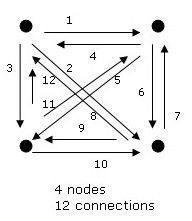
Above is an example of a four-node network. The math actually works out to
value = node^2 - node. Or 4^2 - 4 (12).
This can also be expressed as node * (node - 1). Or 4 * (4-1).
Robert Metcalf's law states that the "value" or "power" of a network increases in proportion to the square of the number of nodes on the network.
In other words, if you have four nodes, or computers, on a network, say, an office intranet, its "value" would be four squared (4^2), or 16.
If you added on addition node, or PC, then the value would increase to 25 (5^2).

Above is an example of a four-node network. The math actually
works out to
value = node^2 - node. Or 4^2 - 4 (12).
This can also be expressed as node * (node - 1). Or 4 * (4-1).
Marc Andreesen, one of the founders of the web, said:
A network in general behaves in such a way that the more nodes that are added to it, the whole thing gets more valuable for everyone on it because all of a sudden there's all this new stuff that wasn't there before. You saw it with the phone system. The more phones that are on the network, the more valuable it is to everyone because then you can call these people. Federal Express, in order to grow their business, would add a node in Topeka and business in New York would spike. You see it on the Internet all the time. Every new node, every new server, every new user expands the possibilities for everyone else who's already there.
(Quoted from the Smithsonian Institution Oral and Video Histories.)
. . . . . . . . . . . . . . . . . . . .
More recently, David Weinberg, writing in his Small pieces loosely joined: a unified theory of the web (Perseus, 2002), pointed me to Reed's Law, a refinement of Metcalf's Law. Weinberg pointed out that Metcalf's Law was formulated in an era of one-to-one communications (e.g., telephone network), but in this day of virtual communities and group communications, there are exponentially more ways in which to create network connections.

If you look at just one node, there are 6 possible combinations
of "groups" for this node (not counting the "solo" group of just
the node, itself).
The math on group combinations from an n-set is 2^n, or 2 to the power of the number of nodes. So, on this re-examination works out to value = 16 for our hypothetical 4-node network (2^4 = 16).
See more at Reed's Law: an interview, Journal of the Hyperlinked Organization, Jan 19, 2001 at www.hyperorg.com/backissues/joho-jan19-01.html.
. . . . . . . . . . . . . . . . . . . .
Another interesting article is Gilder, George. Metcalf's Law and legacy. Forbes ASAP, September 13, 1993. (I've also seen it reprinted on the web.)
Return to the main menu.